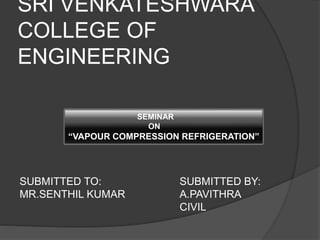Vapourcompressionrefrigeration 140614054320-phpapp02 (1)
- 1. SRI VENKATESHWARA COLLEGE OF ENGINEERING SEMINAR ON ŌĆ£VAPOUR COMPRESSION REFRIGERATIONŌĆØ SUBMITTED TO: SUBMITTED BY: MR.SENTHIL KUMAR A.PAVITHRA CIVIL
- 2. Refrigeration ’āś Vapour Compression Refrigeration
- 3. Refrigeration ’Ƭ Refrigeration is a process of removal of heat from a substance at a temperature lower than the surrounding with the aid of external work. ’Ƭ In a refrigeration system, the rate at which the heat is absorbed in a cycle from the interior space to be cooled is called Refrigerating Effect.
- 4. *In a refrigerator, a medium called Refrigerant continuously extracts the heat from the refrigerator which is to be kept cool at temperatures less than the atmosphere & finally rejects to it. *Refrigerant acts as a heat exchange medium. *e.g.- Ammonia, Freon, Methyl Chloride, Carbon dioxide, Isobutane. *
- 5. Unit of Refrigeration & Ice making Capacity ’éŚ The capacity of a refrigeration system is expressed in tons of refrigeration which is the unit of refrigeration. ’éŚ A ton of refrigeration is the quantity of heat absorbed in order to form one ton of ice in 24 hours when the initial temperature of water is 0┬░c. ’éŚ 1 Ton of Refrigeration = 210 kJ/min = 3.5kW ’éŚ Ice making capacity is the capacity of the refrigerating system to make ice beginning from water to solid. ’éŚ S.I. unit of ice making capacity is kg/hr.
- 6. ’āśThe coefficient of performance(briefly written as C.O.P.) is the ratio of desired effect to the work input. Mathematically, (C.O.P.)refrigerator = Desired effect = Q2____ Work Input Q1-Q2 Coefficient of Performance
- 7. T1=Tsurr Source T1 Heat Rejected, Q1 R Work Input,W=Q1-Q2 Heat Absorbed, Q2 T2<Tsurr Sink T2 Refrigerator ’āśRefrigerator is a reversed heat engine. ’āśIt extracts Q2 amount of heat from sink & releases Q1 amount of heat to source. ’āśInputŌĆöWork(Q1-Q2) ’āśOutputŌĆō Heat
- 8. PARTS OF REFRIGERATOR Parts of Refrigerator Evaporator Compressor Condenser Expansion Valve
- 9. Types of Refrigeration System Refrigeration System Vapour Compression Refrigeration System Vapour Absorption Refrigeration System
- 10. 11 Type of Refrigeration Vapour Compression Refrigeration Refrigeration cycle Condenser Evaporator High Pressure Side Low Pressure Side Compressor Expansion Device 1 2 3 4
- 11. 12 Type of Refrigeration Low pressure liquid refrigerant in evaporator absorbs heat and changes to a gas Vapour Compression Refrigeration Refrigeration cycle Condenser Evaporator High Pressure Side Low Pressure Side Compressor Expansion Device 1 2 3 4
- 12. 13 Type of Refrigeration The superheated vapour enters the compressor where its pressure is raised Vapour Compression Refrigeration Refrigeration cycle Condenser Evaporator High Pressure Side Low Pressure Side Compressor Expansion Device 1 2 3 4
- 13. 14 Type of Refrigeration The high pressure superheated gas is cooled in several stages in the condenser Vapour Compression Refrigeration Refrigeration cycle Condenser Evaporator High Pressure Side Low Pressure Side Compressor Expansion Device 1 2 3 4
- 14. 15 Type of Refrigeration Liquid passes through expansion device, which reduces its pressure and controls the flow into the evaporator Vapour Compression Refrigeration Refrigeration cycle Condenser Evaporator High Pressure Side Low Pressure Side Compressor Expansion Device 1 2 3 4
- 15. Advantages ’üĮ Very mature technology. ’üĮ It has very less running cost. ’üĮ It has smaller size for the given capacity of refrigeration. ’üĮ It can be employed over a large range of temperatures. ’üĮ The C.O.P. is very high. Disadvantages ’üĮ Many systems still use HCFC refrigerants, which contribute to depletion of ozone layer. ’üĮ Initial cost is high. ’üĮ The prevention of leakage of refrigerant is the major problem in vapour compression refrigeration. 16
- 16. 17 Seminar on ŌĆ£Vapour Compression ’ā╝ RefrigerationŌĆØ THANK YOU FOR YOUR ATTENTION















